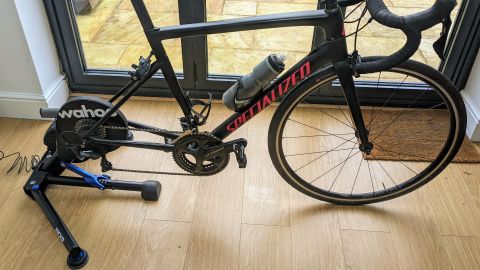Our Verdict
A decade after the Kickr line launched, the V5 helps solidify the Wahoo Kickr as the direct drive turbo trainer – the benchmark to which people compare the alternatives. While the subtle improvements are unlikely to persuade owners of older Kickrs to upgrade, there’s no doubt Wahoo Kickr V5 provides one of the best indoor cycling experiences money can buy.
For
- No need to calibrate
- Realistic ride feel
- Compatible with a variety of bikes
Against
- Price
You can trust Coach
When Wahoo released the first Kickr turbo trainer 10 years ago, it was a seismic moment in indoor cycle training. A decade on, its Kickr V5 is still pushing the boundaries of what’s possible on a stationary bike, providing an immersive experience on those days when heading outside on two wheels just isn’t going to be convenient (or fun!).
So how does it differ from previous versions? On the face of it, it looks nearly identical to the fourth-generation Kickr from 2018. It has the same recessed 16lb (7.3kg) flywheel, a quick-release mechanism, built-in speed and cadence sensors, and a power meter, and is thru-axle compatible. Scratch a little deeper, though, and you’ll notice subtle improvements.
Wahoo has replaced the static feet with Axis feet that allow for a slight 5° of movement from side to side, helping you simulate the real-world experience of cycling. (These feet are also available to purchase separately and are compatible with older Kickr turbo trainers.) It has also improved power accuracy from +/-2% to +/-1% (ensuring your wattage is what it should be) and the machine will now auto-calibrate itself, unlike previous models which required a spin down every once in a while.
- NEWSFLASH: Wahoo Adds Wi-Fi To New KICKR Bike And Turbo
Wahoo Kickr V5: Price
The Wahoo Kickr V5 was released in August 2020 and costs £999.99 (although, at the time of writing, we’ve seen it listed for £899). The Kickr is the top-of-the-range direct drive smart turbo trainer, in a line-up that also includes the cheaper wheel-on Wahoo Snap (£429.99) and smart direct drive Wahoo Kickr Core (£699.99) turbos. (The brand also sells the stationary Kickr Bike for £2,999 if money and space are no issue.)
In layman’s terms, direct drive means that your bike’s drivetrain (the parts that control power transfer from the pedals to the wheels) connects directly with a cassette (the cogs on the back wheel) that is pre-installed on the turbo’s flywheel. This does away with the wheel-on method, common on older or cheaper turbo trainers, where you place your bike’s back wheel on a roller.
The benefit of a direct drive set-up is a more realistic feel, improved resistance and the removal of problems such as tyre slips. The only downsides are the extra expense and the need to find somewhere to store your rear wheel when using your turbo.
The smart aspect allows the turbo trainer’s resistance to be controlled by external software. The Kickr connects to all training platforms such as Zwift, Wahoo SYSTM and Trainerroad, while a fixed wattage or incline can also be set via the Wahoo Fitness app. What’s more, you get free trial passes to Wahoo SYSTM in the box, giving you the chance to find out if that training platform suits you (then the fee is $14.99/£11 a month, or $129/£94 a year).
Wahoo Kickr V5: Set-up
The Kickr V5 is a solid piece of kit that will survive being put through its paces. At 22kg, it’s not the lightest thing to move around, but it’s more than likely that once you’ve set it in place in your pain cave, it won’t be moving a lot anyway.
Setting it up is relatively simple. After unfolding the two supporting legs and adjusting the Axis feet until they’re level on your floor, you just have to plug it into a power source, remove your rear wheel from your bike, and slot it on to the turbo. If this sounds a bit too technical, the instructions feature detailed guides for getting started.
If you’ve not changed your bike’s chain for a while (or ever), it’s wise to do this before installing it on to the turbo’s shiny new cassette – a worn chain will wear down the cassette a lot more quickly than a new chain, and it’ll sound like a bag of nails rather than the claimed “virtually silent riding experience”. Not sure how to do this? Your local bike shop will be able to help.

It’s also worth noting that the Kickr V5 comes pre-installed with an 11-speed cassette. It will work with an eight, nine or 10-speed cassette common on older bikes, or even a 12-speed cassette with a specific adapter. It is also compatible with 130mm and 135mm quick-release axles, and 142x12mm and 148x12mm thru-axles. Again, if in doubt, your local bike shop is your friend.
Wahoo Kickr V5: The Ride
When investing in a turbo trainer, you want something that’s up to the task of powering an avatar around a virtual world. Training platforms like Zwift can’t create an immersive experience if your turbo trainer keeps breaking the illusion.
The Kickr V5 clears this bar with ease. It is able to simulate climbs in SIM mode between 0-20% and specific wattage of up to 2,200 at 40km/h when used in ERG mode – where the turbo automatically sets and amends the resistance for you, which is handy during an interval workout. The upper limits simply show what the trainer, rather than you, is capable of – unless your name is Chris Hoy or Geraint Thomas, that is. In practice, any climb and its various changes in gradient that I attempted on Zwift felt like it would on the road, while in ERG mode I could just focus on turning the pedals during workouts with resistance automatically adjusted as I progressed during the session.

The addition of the Axis feet means an improved feel when out of the saddle on a climb or sprinting hard compared with the previous Kickr V4 and Core models that I’ve ridden, but don’t expect to be throwing your bike from side to side like Mark Cavendish any time soon.
To further increase the realism, Wahoo also sells the Kickr Climb (£449.99), a gradient simulator that lifts the front of your bike up and down alongside virtual gradients. There’s also the Kickr Headwind (£199.99), a fan that adjusts its strength depending on your heart rate and speed, but these are bonus rather than essential additions to your set-up.
Wahoo Kickr V5 Vs Core
One of the Kickr V5’s biggest rivals is its sibling, the Wahoo Kickr Core. It will save you £300, but that’s not the only reason you should consider it as a direct drive smart turbo trainer.
While its max watts and incline are lower than the Kickr V5 (at 1,800w and 16% respectively), this is more than enough for an amateur or even club-level rider. Although it can’t be folded away like its big brother, that’s only an advantage if it’s going to be put in storage over the summer.
The only downsides I can see are that the Kickr Core doesn’t include Axis feet (and won’t ever be able to because of its construction) and that it doesn’t come pre-installed with a cassette. But since the cost of a cassette is a lot less than the £300 price difference, it might just be the best pound-for-pound direct drive smart turbo on the market.
If you must have the best of the best, then it’s tough to beat the Kickr V5, but if you’re happy to settle for a plucky underdog that punches above its weight, then the Kickr Core is the trainer for you.
Is The Wahoo Kickr V5 Worth It?
There’s no getting around the fact that the price of the Wahoo Kickr V5 is more than many people would spend on a new road bike, so it’s not surprising if you’d balk at spending that on a turbo trainer – especially as you need a bike to use it too.
That said, the Wahoo Kickr V5 sits in the middle of other top-tier offerings, like the Tacx Neo 2T (£1,999 RRP) and Saris H3 (£899 RRP), and you’re investing in a solid piece of professional-grade kit that will last you for years to come, as well as keeping its resale value if you find that indoor cycling isn’t for you.
If you already own an earlier Kickr, the differences with the V5 are evolutionary rather than revolutionary, so it’s not worth the additional outlay, plus you can upgrade your current model with the Axis feet (£64.99).
Charlie Allenby is a journalist with a passion for pedalling. He contributes features and buying advice about cycling, and is Coach’s dedicated turbo trainer reviewer. He is also Coach’s chief whey and casein protein powder tester, trying as many brands as possible.
Charlie’s first book, Bike London, is out now. He has written for The Guardian, The Independent and BikeRadar, among others.

This Expert PT Recommends Kettlebell Training For Strength, Power And Cardio Gains—And These Are The Six Exercises To Master First

I’ve Run The London Marathon Six Times—Here Are Four Ways To Set-Up Your Garmin Watch For A Better Race

Forget Crunches, This Exercise Is A Better Way To Build A Strong Core

